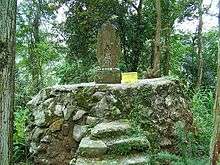Beipu uprising
| ||||||||||||||||||||||
| ||||||||||||||||||||||


The Beipu Uprising (Chinese: 北埔事件), or the Beipu Incident, in 1907 was the first instance of an armed local uprising against the Japanese occupation of Taiwan. In response to oppression of the local population by the Japanese authorities, a group of insurgents from the Hakka and Saisiyat indigenous groups in Beipu, in Hsinchu County, attacked Japanese officials and their families. In retaliation, Japanese military and police killed more than 100 Hakka people. The local uprising was the first of its kind in Taiwan under Japanese rule, and led to others over the following years.
Background
Following the signing of the Treaty of Shimonoseki in 1895 between the Empire of Japan and Qing Empire of China, Taiwan was ceded to Japan in perpetuity, along with the Penghu Islands.[1] The Japanese rule saw Taiwan take large strides towards modernization, as they oversaw improvements to the island’s infrastructure, economy, and health and education systems.[2] Despite this, much of the population still suffered hardships, and there were regular partisan disturbances against Japanese installations.[3] These guerrilla raids often resulted in Japanese reprisals which tended to be more brutal than the initial attack, such as the 1896 ‘Yun-lin massacre', which resulted in 6,000 Taiwanese deaths.[4] Although the situation improved under Goto Shinpei, these disturbances still continued under Sakuma Samata, who succeeded Goto in 1905.[5]
As part of the push for modernisation under Japanese rule, Beipu prospered due to its nearby coal mines.[6] The town of Beipu was predominantly made up of members of the Hakka indigenous group, while people of the Saisiyat ethnic group also lived in the area.[7] As Taiwanese aborigines, rather than Han Chinese, these groups were viewed as barbarians and were particularly likely to face oppression from Japanese rule,[8] especially under Sakuma Samata’s term as governor-general.[9]
The Incident
In response to what was perceived as Japanese oppression, Tsai Ching-lin (蔡清琳) organised a group of insurgents in November 1907. The group, consisting mainly of Hakka with the support of the local Saisiyat aboriginal tribes, seized a collection of weapons in Beipu Township on 14 November. The following day, the insurgents killed 57 Japanese officers and their family members. As retribution, Japanese authorities killed more than 100 Hakka over the following days, the majority of which were young males from Neitaping (內大坪), a small village in the area.[10]
Significance
The Beipu Incident was the first incident of its kind against the Japanese rule in Taiwan. Although other disturbances had occurred since the takeover in 1895, this was the first of a series of local uprisings which flared up quickly, and marked a new phase in armed Taiwanese resistance.[11] Following Beipu, other similar uprisings such as the Ta-pa-ni Incident in 1915 and the Wushe Incident in 1930 occurred, the latter of which ultimately led to a change in approach to Japanese dealings with the aboriginal tribes of Taiwan.[12]
See also
References
- ↑ Roy, Denny (2003). Taiwan: A Political History. Ithaca: Cornell University Press. p. 34. ISBN 9780801488054.
- ↑ Lam, Peng-Er (January 2004). "Japan-Taiwan Relations: Between Affinity and Reality". Asian Affairs: An American Review 30 (4): 251. doi:10.3200/AAFS.30.4.249-267.
- ↑ Lamley, Harry J. (2007). "Taiwan Under Japanese Rule, 1895-1945: The Vicissitudes of Colonialism". In Rubinstein, Murry A. Taiwan: A New History (expanded ed.). New York: M.E. Sharpe. pp. 202–211. ISBN 9780765614940.
- ↑ Lamley 2007, p. 207
- ↑ Lamley 2007, pp. 207–211
- ↑ Dawson, Phil, "Visiting Taiwan – Experiencing Hakka Culture in Beipu" http://phildawson.org/2010/10/17/experiencing-hakka-culture-in-beipu/, accessed 5 October 2011.
- ↑ The China Post, “Beipu Offers Glimpse into Hard-fought Hakka way of Life” http://www.chinapost.com.tw/travel/2004/08/23/51788/Beipu-offers.htm, accessed 4 October 2011.
- ↑ Ching, L. (1 December 2000). "Savage Construction and Civility Making: The Musha Incident and Aboriginal Representations in Colonial Taiwan". positions: east asia cultures critique 8 (3): 800. doi:10.1215/10679847-8-3-795.
- ↑ Roy 2003, pp. 39–40
- ↑ Ching-ting, Yang, “Time to Recall the Beipu Uprising” http://www.taipeitimes.com/News/editorials/archives/2007/11/28/2003390242/1, accessed 4 October 2011.
- ↑ Lamley, “Taiwan Under Japanese Rule, 1895–1945: The Vicissitudes of Colonialism", p. 211.
- ↑ Ching 2000, pp. 797–799